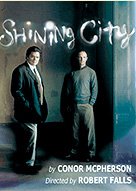 "Shining City" is Conor McPherson's new play presented by Manhattan Theatre Club at the Biltmore Theatre. Starring Oliver Platt, Brian O'Byrne and Martha Plimpton, the potential for this show seemed boundless.
"Shining City" is Conor McPherson's new play presented by Manhattan Theatre Club at the Biltmore Theatre. Starring Oliver Platt, Brian O'Byrne and Martha Plimpton, the potential for this show seemed boundless.(Spoiler alert - ending plot twist revealed in this review.)
Mr. O'Byrne plays Ian, a new therapist who had been a catholic priest not so very long ago. He's just set up his office in a run-down building in Dublin. Mr. Platt is John, one of Ian's first patients. Ms. Plimpton has a brief but expository appearance as Neasa, Ian's girlfriend and the mother of their infant daughter.
John arrives as an obvious emotional wreck. A roll of offstage thunder accompanies him. (That seemed a little too much telegraphing for my taste.) He reveals that his wife has recently died following a car accident. He feels significant guilt over her death because their relationship had become somewhat distant in the months leading up to her death. His nervous state turns out to be the result of coming into his house, opening a door and when he closes it, he sees the ghost of his wife hovering there, trembling, bloody and reaching for him, in their home. Desperate for validation he demands to know if Ian believes him. Ian, who has little to say during the scene tries to be supportive without explicitly agreeing.
The next scene introduces Neasa, concerned about having to live with Ian's brother and family with their baby. Ian announces that he's working on getting her a place of her own, and attempts to end their relationship as lovers. During the exchange, Neasa reveals that she was unfaithful to Ian before she got pregnant. The turnabout of pain and recrimination for the problems in the relationship bounce about plenty in this scene. Neasa arrived in a mood to fight about the living situation, but leaves with an apology to Ian "...it's not your fault."
John returns, looking a little more together, but as it turns out, really isn't yet. He reveals a flirtation with another woman that almost became an affair. It ended clumsily and he ended up in a brothel in another situation that did not consummate. After returning home from the brothel, he had lashed out at his wife quite violently and lets us know that her death and haunting of him is his punishment.
The next scene, oddly, finds Ian returning to the office with Laurence, a street hustler. Laurence has a wounded hand from a firecracker accident. Strangely, Laurence is the only character whose wounds are physical. In a moment of reversal, Ian sits down on the couch for the first time and Laurence is in the therapist's chair. Ian breaks down as Laurence attempts to get down to business confessing he's never been with another man before. Laurence comforts him, but that seems to be the extent of their contact.
In the final scene, Ian is packing up to move. He's trying to wrap a teddy bear, presumably for his child, but doesn't have enough paper. This seems to demonstrate the running theme for Ian's inability to make things fit. John arrives with a gift to thank Ian for his help. He has moved on, having sold the house and bought an apartment. Time to start fresh. Ian tells him of his own move to Limerick to be with Neasa, to whom he is now engaged. John has seen the woman from his flirtation, realizing there never really was a connection with her. He says of his ghostly visions "Seeing something is one thing. How it makes you feel...is the reality." Ian holds the door open as John leaves. Ian closes the door to reveal the ghost of John's wife, trembling, bloody and reaching for him as the curtain falls.
Other than Mr. McPherson being Irish and born in Dublin, I was uncertain why this play was set there. Nothing in the plot seemed to require that, nor did any of the characters seem to have any traits that seemed particularly Irish. It could have easily been New York, Chicago, London or any large city.
As the play progressed, I kept thinking to myself that there are some great monologues here, but it's doesn't feel very cohesive - just a collection of random scenes tied together by a single character. This shocking image of the dead wife at the end seems to be that Ian has only helped John by assuming his guilt, and as a result, the burden of this ghost.
Mr. Platt brings his usual rapid-fire, sometime non-sequitur-ish, acting style to John. He gives John a decent humanity to a flawed man. Mr. O'Byrne didn't really have as much to do in this role, compared to his last two Tony-nominated appearances in "Doubt" and "Frozen." He spent most of his time listening to Mr. Platt, effectively giving us a picture of man in transition, unsure of where his life will lead. Ms. Plimpton's Neasa was quite compelling, arriving in a blustery fury and quite successfully transforming from accuser to one accused and guilty.
Robert Falls has given this 100-minute (no intermission) set of scenes as much cohesiveness as he can. Transitions and passing of time is accomplished with Mr. O'Byrne doing the heavy lifting (sometimes literally) bringing props and furniture on and offstage between scenes. Santo Loquato's dilapidated office and darkened skyline bring the appropriate Irish brooding to the proceedings. The large window upstage center evokes a cross with the top cut off, perhaps a reference to Ian's departure from the priesthood, which is usually accompanied by excommunication in the Catholic Church. Christopher Akerlind's lighting complemented the sets and direction quite nicely.
Of the other Manhattan Theatre Club shows I've seen at the Biltmore - "Rabbit Hole," "Sight Unseen," "Reckless," "The Violet Hour," this one was very good, but not great.


No comments:
Post a Comment